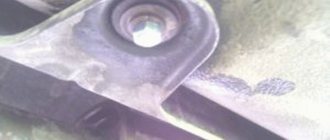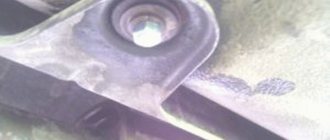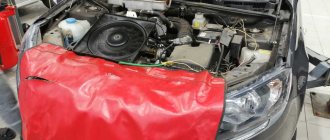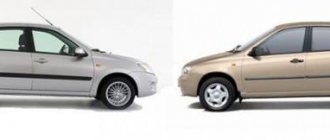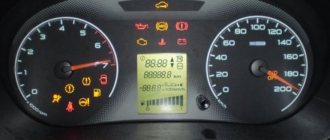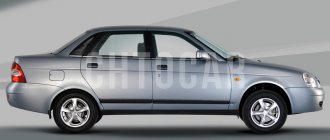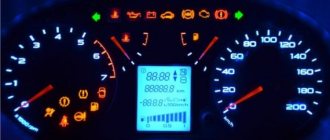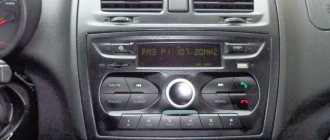Granta 4 new size
Previous materials:
about checking the chassis and transmission
check the steering
According to the maintenance regulations, we check the condition of the brake system every 15 thousand km.
We carry out the work on an inspection ditch or overpass.
To check the functionality of the vacuum brake booster when the engine is not running, press the brake pedal 5-6 times and, holding it down, start the engine. If the vacuum booster is working properly, after starting the engine the pedal should move slightly forward. If this does not happen or the braking is not effective enough (you have to press the brake pedal with great force), you need to check the tightness of the connections of the vacuum supply hose to the vacuum booster and the serviceability of the booster itself.
We check the condition of the brake pipes. The tubes must be securely fastened in the holders and have no dents, mechanical damage, deep corrosion, or signs of brake fluid leakage. If necessary, we tighten the connecting fittings or replace faulty parts.
We inspect the brake hoses; there should be no cracks, tears or abrasions on them.
We check the condition of each hose by creating fluid pressure in the brake system. To do this, the assistant must press the brake pedal firmly and hold it during the inspection. The appearance of rubber swelling or brake fluid leakage from the hose and its tips is not allowed. If damage is detected, replace the hoses as a set.
We check the condition and degree of wear of the brake pads and discs of the front wheels. To check, remove the front wheels one by one.
Which discs are better for Grants in different conditions?
Three different types of brake discs are installed on the Granta. Often users install similar parts from foreign cars to speed up the ride or to save money.
In the city and on the highway
Under normal operating conditions, factory cast iron discs or any other equivalents are suitable. If you have the original 13s and are not enough, change to a 14th size. It's easy to change them, and the car will brake much better.
Remember that you have an inexpensive sedan, not a race car. Do not overheat the brakes and if you drive through a water obstacle in the form of a puddle, dry them by briefly pressing the brake pedal. It doesn't make sense to pay more for ceramics for quiet use.
For lovers of fast driving
If you like to race, think about good brakes. For this purpose, 15-size perforated wheels with grooves or other sports wheels are suitable for the Granta. If you have a passion for this car and you are tuning it, install ceramics. Although it is expensive and needs to be warmed up, it is best suited for sports use.
Granta 41 1 new size
Through the caliper window we estimate the thickness of the brake pads.
We replace the brake pads of both front wheels if the thickness of the friction lining of any of the pads has reached the maximum permissible value - 1.5 mm.
Rotating the brake disc, inspect its working surfaces on both sides. There should be no cracks or deep grooves on the working surfaces of the disc.
Front pads for Granta
| Thickness | Width | Height |
| 17.3 mm | 104.4 mm | 61.9 mm |
Dimensions of original LADA Granta front pads
Lada Granta front brake pads without anti-squeak plates have the article number - 11180-3501080-00 . More modern pads with a plate that prevents vibration and noise are listed under the article number - 21920-3501080-10 .
Also in many catalogs of replacements for original spare parts you can find crossed numbers of brake pads suitable for the Lada Granta:
Lada Granta brake pad dimensions
- 21083501080;
- 21083501089;
- 211003501080;
- 21100350108000;
- 21100350108001;
- 21100350108900;
- 21103501080.
Granta 41 2 new size
Using a caliper we measure the thickness of the disk, which should be at least 17.8 mm.
If, as a result of wear, a high shoulder has formed on the maximum diameter of the disk, which prevents an accurate measurement, remove the shoulder using a file or other method, or measure the thickness of the disk with a micrometer. We replace a brake disc with defects in the working surfaces or extreme wear.
The degree of wear of the brake pads of the rear wheel is assessed by the condition of the front pad, which wears out faster than the rear one.
Rules for choosing brake discs
To select suitable spare parts of this type, when purchasing products, it is recommended to focus on the following points:
- Material. It is recommended to give preference to brake discs made of high-carbon cast iron. The fact is that this particular material is resistant to high and low temperatures, as well as temperature changes. In addition, it is characterized by increased strength and is therefore less susceptible to deformation and cracking. Therefore, high carbon cast iron discs will last for a long time.
- Presence of anti-corrosion coating. It increases the service life of spare parts.
- Manufacturer. Professionals recommend giving preference to trusted brands, since they guarantee the high quality of their products.
- Price. In this case, you need to focus on your budget size. Even among inexpensive discs, you can choose high-quality spare parts.
So which brake discs are best for the Lada Granta? It all depends not only on the characteristics of the spare parts, but also on the size of the budget. So, if you need inexpensive front discs, then pay attention to the Bosch model 0986479346. If you decide to purchase front discs made of high-carbon cast iron and cost is not the main selection criterion for you, we can recommend you the ATE PowerDisc product. If you need discs for the rear axle, we advise you to take a closer look at the BM BDV 292 option. Our TOP and tips will help you choose suitable brake discs for the Lada Granta.
Granta 41 5 new size
...and through the window we assess the condition of the front brake pad lining.
If the lining thickness is less than 1.5 mm, the brake pads of both wheels must be replaced.
To check the condition of the wheel cylinders and brake drums of the rear wheels, remove the drums (see “Replacing the brake pads of the rear wheels”).
There should be no cracks or chips on the drums. If the working surface is severely worn, or if there are grooves, we replace the brake drum.
To check the condition of the wheel cylinder sealing collars, one by one on each side...
Rear pads for Grants
Lada Granta rear brake pads with number 2108-3502090 are also equipped on VAZ 2110, Kalina, Priora and Samara cars that do not have an ABS system.
Rear brake pads on Grants with ABS are numbered 21920-3502090-10. For retail, product code 21920-3502090-55 is used.
They differ from the previous ones by the presence of a hole for the wheel rotation sensor. Identical components are used on VAZ 2110, second generation Kalina, Priora, Samara cars with an anti-lock brake system.
These clutches are supplied to the AvtoVAZ conveyor by JSC TIIR. The TIIR-444 composite overlay itself is marked with article number 2192-3502105. The improved composition of the linings is designed to increase the tenacity of the rear brakes especially for cars with ABS.
Lada Granta rear clutch parameters:
| Rear pad article number | Diameter | Thickness | Width |
| 2108-3502090, 21920-3502090-10 | 200 mm | 4 mm | 41 mm |
Granta 42 2 new size
We inspect the pressure regulator in the brake mechanisms of the rear wheels and its drive.
The regulator and drive must not be damaged; brake fluid must not leak from the regulator and brake pipes. The regulator piston should not be jammed - when the brake pedal is pressed, the regulator rod should move.
Inspect the parking brake cables. There should be no damage to the sheaths on the cables. Cables in sheaths must move freely, without jamming. We replace defective cables with new ones. You also need to replace the cables if they are stretched so much that the parking brake cannot be adjusted.
We check the functionality of the parking brake. If necessary, adjust the parking brake .
The parking brake should hold the vehicle on a 23% grade.
The full travel of the parking brake lever should be from 2 to 4 teeth (clicks) of the lever ratchet device.
To adjust the parking brake, place the car on an inspection ditch or overpass and lower the parking brake lever.
Reasons for replacing spare parts
One of the main reasons for replacing brake discs is natural wear and tear. In addition, it is recommended to install new parts instead of old elements in the following cases:
- premature failure of discs, which can be determined by deterioration in the quality of braking of the car;
- damage to product surfaces;
- deformation of spare parts.
Attention! In any of these cases, it is recommended to replace the brake discs to avoid a dangerous situation while the vehicle is moving.
Video - When to change brake discs
Granta 42 4 new size
Holding the adjusting nut of the cable end with a 13mm wrench, use a head of the same size to unscrew the locknut.
Rotate the adjusting nut clockwise to tighten the cables.
It is convenient to adjust the tension of the cables with a high head with a ratchet and an extension. In this case, we do not completely unscrew the locknut, but, having aligned its edges with the edges of the adjusting nut, put on the high head “13” and rotate both nuts at once.
Use a locknut to secure the adjusting nut. When the lever is lowered, the suspended rear wheels should rotate freely.
More information about the design, maintenance and repair of Lada Granta can be found in our Wikipedia (link)
Lada Granta: checking the brake system
Original
The advantage is exact compliance with the specified dimensions. After purchasing the part, there is no need to adjust it to size or grind it down:
| Name | vendor code | Cost per 1 piece, rubles |
| AvtoVAZ | 11180-3501012-10 | From 2 thousand rubles |
Various manufacturers can be the manufacturer of original parts of this type for cars. But the products are labeled as AvtoVAZ. The quality is up to the mark. A special alloy of cast iron is used. It is allowed to use pads whose friction linings include ceramics.
What's the result?
The accuracy of all operations is about 2-3 hundred parts, which is comparable to the characteristics of inexpensive new disks and sometimes higher than the manufacturing accuracy of frankly cheap “non-original” Chinese versions. Of course, a new brake disc is guaranteed to have a greater thickness reserve, but a machined one will differ from it only in terms of service life, but not in quality of work. If we talk about the financial benefits, then they are obvious: the average price for a complete disc grinding with removal and installation is 1,500 rubles. To ensure uniform braking of the axle, the discs are machined in pairs. As a result, it turns out that even at the minimum price of the original disc with installation, the groove costs almost half as much, and the necessary characteristics of the mechanism are not lost.
The thickness of the brake disc and pads is a fundamental factor in the braking distance, connected by an inversely proportional relationship: the thinner the elements and the more damaged they are, the more time and distance it will take to come to a complete stop, and the count is in meters and seconds. Just imagine that at a speed of 40-60 kilometers per hour - the normal driving mode for a city without traffic jams - you have lost 4 meters... It’s the same as stopping not in front of a pedestrian crossing, but entirely on it, or “entering” another whole building car or other obstacle. Of course, it’s better not to imagine the possible consequences.
Our position is described in a separate article, but today we will show how exactly the thickness of the brake disc and pads is measured. For the brake disc, you will need either a shortened caliper or a thickness gauge; measurements are taken no closer than 25 millimeters from its outer edge, otherwise the measurement error will be too large. The VAG group standard for disc wear from the nominal value for the front axle is no more than 3 millimeters, for the rear axle – no more than 2 millimeters, and these are the most gentle conditions; Americans, for example, have tolerances of no more than 2.2 mm for the front axle.
The thickness of the front brake pads is usually 14 millimeters, and we are talking specifically about the ferodo pad without taking into account the backing plate. 4 millimeters is the first call, a signal, a recommended but not yet mandatory measure, 2 millimeters is already an alarm bell, a limit beyond which it is better not to cross. For measurement, there is a special set of probes from 2 to 10 millimeters in increments of one, for greater clarity, marked in the colors of the traffic light.
The thickness of the rear brake pads is somewhat smaller, usually around eleven units, but the requirements for them are the same as for the front ones, four and two millimeters, respectively.
When an owner asks to “look at the pads,” he often has no idea that his car is hanging on a lift without wheels, and we “look” at the pads exclusively with tools. All other types of diagnostics, carried out by eye, are pure fraud, how many cases have there already been when mechanics were deceived, mistaking the support plate for the block itself, and how can you tell us to examine the inner block if we don’t have eyes on a stalk like a snail’s.
In conclusion, we add that these are tolerances for civilian cars, which fans of sports versions call “vegetables”. Sports versions, especially ceramic ones, are much more demanding and have tighter tolerances for the condition of the system and the thickness of both pads and discs.
Analogs
The selection of replacements for original parts includes several dozen items. The highest quality and relatively inexpensive are the following:
| Name | vendor code | Cost, per 1 piece, rubles |
| Alnas Sport, ventilated perforated | 2112-3501070-03 | From 1 thousand rubles |
| Notched, “PowerDisc”ATE | 24.0320-0142.1 | From 1.5 thousand rubles |
| BREMBO MAX | 09.8903.75 | From 1.2 thousand rubles |
"Native" articles
The table shows the original part numbers of brake discs suitable for Granta.
| Front | Rear and kits |
| R13 21100- 3501070-01 | R14 11196-3502070-00 |
| R14 21120-3501070-00 | R13 21100-350107088 |
| R14 2120-3501070-02 | R14 21120-350107088 |
There are high-quality analogues on the market. To understand which ones to choose , it is advisable to study the advantages and properties. shortcomings of products, listen to the opinions of users and experts.
Analogs
The cost of original components is an order of magnitude higher than analogues. Therefore, the choice of many vehicle owners falls on substitutes. The most advantageous offers:
| Name | vendor code | Cost, rubles |
| A.S.P. | 2702220 | 2 thousand rubles. for 1 piece |
| B.M. | BDV 885 | 1 thousand rubles for 1 piece. |
| Hella | 8DD355109331 | 1.6 thousand rubles for 1 piece. |
Disc brakes
Disc brakes are more modern and efficient, but require more frequent brake pad replacement.
Signs of Brake Pad Wear
A lot can be said about the importance of good functioning of the braking system. There are many parts in the system that can fail: vacuum booster, pipelines and hoses, brake master cylinder and much more.
All this requires attention and timely maintenance, but for now we will talk exclusively about the wear and tear of the main consumable components.
Vibration during hard braking. Worn brake pads show that the wear process is uneven. A worn brake pad makes noise, and when braking sharply, noticeable vibrations spread throughout the body.
Of course, similar behavior of the brake system can also occur when the brake disc wears out, so it is important to diagnose all elements. Brake disc wear is described in more detail below.
Inadequate vehicle response when braking. Newly installed brake pads require a little grinding in to ensure they are fully seated on the brake rotors and provide maximum braking performance. With new pads, the braking process is predictable, but with worn ones, braking may be weak or excessively sharp. In the first case, there is not enough braking force due to the pads being too thin; in the second, the pads are completely worn out, so the brake disc and caliper come into contact - this leads to metal-on-metal friction.
Metal shavings in brake dust on wheel rims. The formation of dust from the pads on the wheel cap is normal if there are no metallic impurities in the dust. But small inclusions of metal shavings are a clear sign that it is time to change the pads, as they scratch the disc. Please note that this brake wear monitoring method is not suitable for ventilated brakes or when using alloy wheels.
Determining the level of wear:
To accurately determine wear, it is best to use a visual inspection. This is long and requires removing all the wheels, but it gives a clear answer to the question: is it time to change the brake pads or not. Inspection can be done through a special hole in the caliper. Modern cars have special sensors that will notify the driver in time about the upcoming change of pads. Usually the warning light goes off a little early. Simple and effective mechanical wear indicators can also be used. It is optimal to think about changing brake pads when their thickness is halved or reaches the level recommended by the manufacturer.
Signs of brake disc wear
The brake pad is the main consumable in disc brake systems, but this does not mean that the brake disc will last forever. It also wears off over time, although this process can take many years.
You can determine brake disc wear by the behavior of the car during braking:
- Vibrations on the steering wheel and car body;
- Grinding noise from the front, in the area of the front wheels;
- Jerks;
- Extraneous noise.
And also upon visual inspection:
- Curvature of the brake disc;
- The presence of noticeable recesses;
- Presence of cracks.
The reasons for brake disc wear can be very different. The most common thing is a long service life, when the disk wears out evenly and gradually begins to crumble and collapse at the edges due to the very small residual thickness. The disc may wear unevenly if the brake pads are not replaced in time. Then the metal elements of the pad and caliper begin to touch during braking and leave deep grooves on the disc.
The disc may become warped due to improper use of the vehicle. The most common reason is overheating of the brake disc as a result of long and intense braking. A striking example is the long descents that novice drivers drive on the brakes and allow the discs to overheat.
Determining the level of wear:
- Remove the wheel;
- We measure the thickness of the disk.
The brake disc wear is allowed to be no more than 2-3 mm compared to a new one. For the brake systems of different cars, the optimal thickness of a new disc is different. Specific values of permissible wear are indicated on the disc itself in numbers and can be duplicated by special grooves that clearly show the wear limit.
The procedure for replacing brake discs on a Lada Granta car
You can do all the work yourself (it varies slightly for the front and rear elements). Prepare tools and accessories. These include:
- the disks themselves;
- jack;
- a set of suitable keys and sockets (7, 13, 17 mm, Torx t12);
- hammer;
- lubricant.
Front elements
Replacing brake discs on the front wheels of a Lada Granta is carried out as follows:
- They remove the wheel and put the car on a jack.
- The guide clamps are removed, the stupor is folded back, and the brake pads are removed.
- The bracket is installed on the suspension.
- Unscrew the disc fasteners, lubricate and dismantle them. If the procedure is difficult, lightly tap the part from the reverse side.
- Install and secure new parts.
